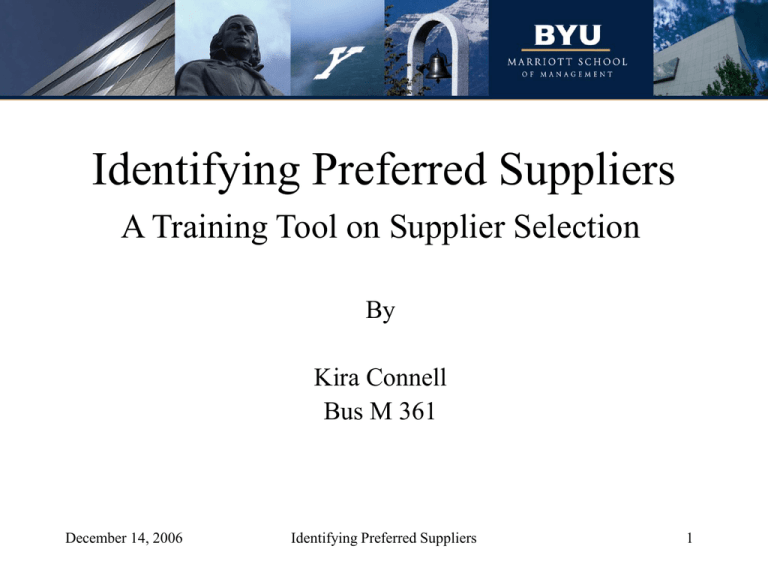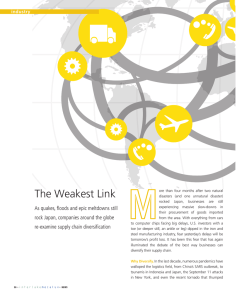
Identifying Preferred Suppliers
A Training Tool on Supplier Selection
By
Kira Connell
Bus M 361
December 14, 2006
Identifying Preferred Suppliers
1
What Will Be Covered
1. Supplier Selection Defined
2. Brainstorming Exercise: How Can This
Tool be Used in Your Organization?
3. Important Criteria in Supplier Selection
4. Application: Supply Base Reduction
5. Example and Exercise for Supplier
Selection
December 14, 2006
Identifying Preferred Suppliers
2
Supplier Selection Defined
• Supply chain: “a network of manufacturers and
service providers that work together to convert
goods from the raw materials stage to the end
user” (Bozarth and Handfield, 4)
• Supplier: an entity that supplies goods or services ;
network of suppliers combine to form a supply
chain
• Supplier selection: the process of identifying and
choosing an appropriate supplier
December 14, 2006
Identifying Preferred Suppliers
3
Brainstorming Exercise
• Why is a reliable and quality supplier
important to your organization?
• What are the major effects of a poor
supplier on your business?
• How does this affect the final customer?
December 14, 2006
Identifying Preferred Suppliers
4
Ray Carter’s 10 C’s to Supplier
Selection
•
•
•
•
•
Competency
Capacity
Consistency
Control of process
Cost/price
December 14, 2006
•
•
•
•
•
Commitment to quality
Cash/finances
Clean
Culture and relationship
Communication
Identifying Preferred Suppliers
5
Competency
• Supplier must have core skills associated with the
goods or services they are providing
• Look for the following:
– Internal systems to ensure competence/effectiveness
– Appropriate number of staff in each skill area
– Adequate supervision ratio of managers to employees
December 14, 2006
Identifying Preferred Suppliers
6
Capacity
• Supplier must have sufficient resources to provide
adequate amount of goods or services
• Look for:
– Flexibility in volume changes
– Percent of annual turnover your contracts comprise
– Subcontracting
December 14, 2006
Identifying Preferred Suppliers
7
Consistency
• Supplier should consistently provide accurate,
timely, and quality products
• Consider the following:
– Does the supplier have adequate facilities and updated
technology?
– Does the vendor frequently ask for concessions or
require rework?
– Is the supplier ISO 9000 certified?
December 14, 2006
Identifying Preferred Suppliers
8
Control of Process
• Supplier must have control over the systems and
people that control resources, inventory, budgets,
and processes
• Assess whether:
– The vendor can adapt these systems when necessary
– The supplier monitors actual performance against the
process
– The vendor has a corrective program in place
December 14, 2006
Identifying Preferred Suppliers
9
Cost/Price
• Supplier should provide their goods or services at
a competitive and reasonable price
• Also consider:
– Payment and interest terms
– Additional costs
– An unusually low price which may indicate a
misunderstanding of the scope of the work or an
intention to cut corners on quality or safety
December 14, 2006
Identifying Preferred Suppliers
10
Commitment to Quality
• Supplier should be committed to providing a
quality product
• Also look for:
– Management inspections, quality control standards,
evaluation mechanisms
– Operating and maintenance instructions, quality plans,
certificates of conformity
– Service record with other buyers
December 14, 2006
Identifying Preferred Suppliers
11
Cash/Finances
• Supplier should have sufficient cash funds
to ensure that it will remain in business
• Look for:
– A company’s financial records and ratios
– Evidence of having “a challenging year” or “a
year of consolidation”
– Willingness to provide a financial guarantee
December 14, 2006
Identifying Preferred Suppliers
12
Clean
• A supplier should be environmentally sound
and a safe workplace
• Look for evidence of:
–
–
–
–
Compliance with government regulations
Accident statistics
Regular safety inspections
Safety awards
December 14, 2006
Identifying Preferred Suppliers
13
Culture and Relationship
• Supplier should be able to match the requirements
of your contract
• Consider:
– Is the supplier committed to an open working
relationship built on trust?
– Does the contractor understand what benefits you are
seeking and what value they can add?
– Is the contractor able to work within your cultural
barriers?
December 14, 2006
Identifying Preferred Suppliers
14
Communication
• Supplier should be fully integrated with
information and communication technology
• Look for:
– Whether the company has the technology to
immediately receive information regarding
changes in an order
December 14, 2006
Identifying Preferred Suppliers
15
Supply Base Reduction
• Defined as “the process of and activities
associated with reducing the number of
suppliers that an organization utilizes”
(Odgen, 30)
• Many companies now using supply base
reduction as a method to improving supplier
selection
December 14, 2006
Identifying Preferred Suppliers
16
Pros/Cons of Supply Base Reduction
• Pros
– Closer relationship with supplier
– Easier to communicate
– More reliable
• Cons
– Prevents competition which may raise prices
– Less flexibility in volume
December 14, 2006
Identifying Preferred Suppliers
17
Real World Example:
Harley-Davidson
• Example of effectiveness of supply base
reduction
– Reduced its less-than-truckload (LTL) carrier
base from 68 to 7
– Trimmed $1.5 million in transportation costs
– On time performance up 2.5 percent
– Service failures substantially reduced
December 14, 2006
Identifying Preferred Suppliers
18
Practical Exercise
• Assignment: break up into groups of 4-5 students and rank
the four suppliers you are given, identifying the preferred
supplier
• Instructions:
– Consider the following five suppliers
– Identify most important criteria for supplier selection
– Rank each of the five suppliers based on criteria and justify
reasons for preferred supplier
Note: you manufacture wooden tables and chairs and are
looking for a vendor to supply wood
December 14, 2006
Identifying Preferred Suppliers
19
Suppliers for Practical Exercise
• Supplier #1: good cost and quality; bad
consistency and control
• Supplier #2: good consistency and capacity; bad
quality
• Supplier#3: good competency and cash; bad cost
and culture
• Supplier #4: good clean and communications; bad
cash
December 14, 2006
Identifying Preferred Suppliers
20
Discussion Q’s for Exercise
• Which supplier is preferred and why?
• Should your organization consider using more
than one of the suppliers?
• What effect does the industry have on which
criteria you consider most important?
• What are the pros and cons of having a limited
number of suppliers? Of having multiple
suppliers?
December 14, 2006
Identifying Preferred Suppliers
21
Summary
• Identifying and selecting preferred suppliers
is an objective process
– There is no formal solution or process
– There are important criteria that can be used to
help identify the best supplier
– Using these criteria still involves value
judgment
December 14, 2006
Identifying Preferred Suppliers
22
Readings
•
Introduction to Operations and Supply Chain Management, by Cecil C.
Bozarth and Robert B. Handfield, Pearson Prentice Hall, 2006
•
Making the Right Choice, by Alan Oxenbury, Supply Management, July
2006
•
The Final Countdown, by Alan Oxenbury, Supply Management, August 2006
•
How Many ‘C’s in Partner?, by Neil Fuller, Supply Management, September
2005.
•
Supply Base Reduction: An Empirical Study of Critical Success Factors,
by Jeffrey A. Ogden, Journal of Supply Chain Management: A Global Review
of Purchasing & Supply, November 2006.
December 14, 2006
Identifying Preferred Suppliers
23





